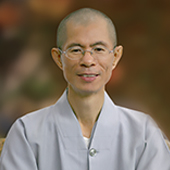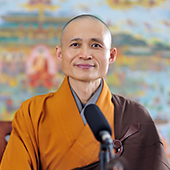Who is Your True Dharma Teacher in an Age of Confused Views?
Master Tanluan, when explaining the Difficult Path practice, listed “Five Obstacles” that make it difficult for a practitioner to attain non-retrogression from Buddhahood. The first obstacle is “non-Buddhist paths that appear virtuous but distort the Bodhisattva teachings.”
Many non-Buddhist paths, especially those that appropriate Buddhist concepts, can be highly misleading. At first glance, they might seem roughly similar to Buddhist teachings, as many of them encourage people to do good. They also offer practical solutions to certain daily life and well-being issues. However, they are not authentic Buddhist teachings and they distort the correct understanding of true Buddha Dharma. As a result, people’s minds are muddled and they don’t get to know the real Buddhist teachings. This is what is called the “turbidity of views”, one of the Five Turbidities, meaning confusion over and misunderstanding of the basic tenets of Buddha Dharma. This turbidity of views is particularly serious in the turmoil of our current Dharma-ending age. Despite the rapid social and economic progress, people today feel spiritually empty. Many Buddhist-appropriating paths are meeting the growing demand for religious faith.
I. It’s a Lesser Evil to Break Precepts than to Compromise Correct Views
On our journey of learning the Dharma under such an environment, correct understanding of Buddha Dharma, or the Right View is vital. The Right View is like our eyes, and putting the right view into practice is like our legs. Only with the use of both our eyes and legs can we move forward smoothly and reach our destination. If the eyes fail, we will be wandering aimlessly.
The first element of the Noble Eightfold Path is the Right View - correct understanding of the Dharma.
Our understanding and views shape our practice. Even if our practice falls short of perfection and we achieve only a fraction of it, or even if it’s somewhat biased, as long as those understandings are correct, we won’t go too far astray.
There’s a saying, “Breaking precepts is the lesser of two evils when compared to compromising the right view.” If a cultivator violates precepts, with repentance and making amends, he can still attain liberation as long as his views are correct.
On the contrary, if his views are flawed, he is destined to be trapped in the cycle of birth and death no matter how advanced his cultivation may be. In fact it can be dangerous, like a person who earnestly believes he’s going the right way but who drives his car straight towards a cliff.
II. True Dharma Teachers are Those with Right Views
In this day and age, what exactly is a true Dharma teacher? It’s not necessarily the person who outwardly makes the most strenuous effort in their practice. The Noble Eightfold Path includes the “Right Effort”, but not all effort is right. Some people practice with great zeal, but they’re completely off track. They’re running at full tilt, but the faster they go, the further they get from their goal.
Nowadays, a true Dharma teacher is someone who can elucidate clearly the correct Buddhist teachings so that others can understand and apply them. Do not judge this person by his practice, but by whether he has the right view or not.
For example, a person looks most ordinary and has all the worries in the world, but he is a true Dharma teacher if he can explain that we are all subject to the endless cycle of birth and death (samsara), and that by simply reciting “Namo Amitabha Buddha”, we can be reborn in the Pure Land, attain Buddhahood and be liberated from samsara.
The Surangama Sutra says, “There will be as many teachers who propound false Dharma as there are grains of sand in the River Ganges.” How can we tell if the Dharma a person teaches is false?
We adopt three criteria to evaluate his teachings.
1. Comparison to the sutras. The sutras, spoken by Shakyamuni Buddha, are unquestionably infallible.
2. Alignment with patriarchal teachings. The patriarchs, who pass on the Buddha’s teachings based on their enlightened wisdom, are unlikely to misguide us.
3. Observation of real-life results. Facts are self-evident and speak louder than any eloquent argument. For example, some may wonder, “How can merely reciting the Buddha’s name lead to rebirth in the Pure Land?” Those who assist with Amitabha-recitation for people near death or just observe what’s happening around them often witness the answer. They see for themselves that someone who has never practiced Amitabha-recitation their whole life passes away peacefully after reciting the Buddha’s name just a few times before death. Sometimes, their departure is even accompanied by all sorts of auspicious manifestations (such as the body remaining soft and supple long after death.)
If a person’s teachings are at variance with these yardsticks, their views are likely to be impure and incorrect.
This way of evaluating teachings is fairly reliable. A wise person should use these three criteria to discern the truth.
III. Sincerely Reciting Amitabha’s Name with Firm Faith
Authentic Buddhist teachings are down-to-earth and unassuming. However, people today are often naive and gullible, and what is most troubling is that once they form an initial impression, it’s very difficult to change it.
The landscape of religious beliefs today is indeed chaotic. Sentient beings are in a pitiful state. Master Tanluan pointed this out 1,400 years ago, showing that this is not a problem unique to our time. Without a good Dharma teacher to guide us in understanding genuine teachings, we are left helpless and often too confused to distinguish right views from wrong views.
If we cannot do that, let’s just sincerely recite Amitabha’s name!
Let Amitabha’s name become our life - the name is Amitabha Buddha himself.
Live each day simply, immersed in Amitabha’s life through a single-minded practice of Amitabha-recitation, without worries or discrimination.
Believe that reciting Amitabha’s name will lead us to rebirth in the Land of Bliss with unwavering faith, regardless of any dissenting voice.
(Translated by the Pure Land School Translation Team;
edited by Householder Fojin)
Guiding Principles
Faith in, and acceptance of, Amitabha’s deliverance
Single-minded recitation of Amitabha’s name
Aspiration to rebirth in Amitabha’s Pure Land
Comprehensive deliverance of all sentient beings


